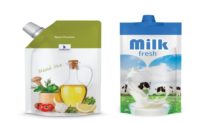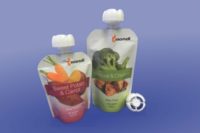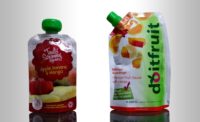According to the Flexible Packaging Association, the U.S. flexible packaging industry grew 2.8% to $27.2 billion in annual sales, but we don’t need statistics to see that flexible packaging is on a roller coaster that only goes up. A single trip to any grocery store offers up shelves and shelves of evidence that flexible packaging is bending its way into every market possible.
Spouting new pouches
This means more companies will be looking to their packaging suppliers to meet that need. Eagle Flexible Packaging (eagleflexible.com) has expanded its offerings by introducing spouted pouches because these packages continue to grow in popularity and because of the uniqueness and the ability to differentiate products on the shelves. To accommodate a variety of needs, Eagle Flexible Packaging offers pouches that can be customized. Spouted pouches are reclosable, which makes them a good match for grab-and-go products. The pouches can even be made with die-cut handles for better portability. In addition to being customizable, recloseable and portable, spouted pouches offer great flexibility in the types of products they can hold including food, beverage, condiments, dry mixes, pet food, granulates and powders.
Filling customer needs
According to L.E.K. Consulting (as reported by Ampac), spouted pouches will grow more than 15% from 2013 to 2017. Also, aseptic stand up pouches will grow 78% from 2013 to 2107. To meet the demands of the market, Ampac (ampaconline.com) has re-introduced the AseptiPouch®, a packaging format for cold aseptic applications. The pre-made stand up AseptiPouch offers a unique fitment, which has a flip top cap that is removed prior to filling and immediately reclosed after filling. It is engineered for processing on an Astepo aseptic filling machine. Because the pouches are gamma irradiated (sterilized) and shipped for the filling process, the AseptiPouch differs from alternative FFS aseptic packaging systems that require the laminate web to be immersed in a peroxide bath for sterilization before forming into a pouch.
AseptiPouch also offers cost savings and reduced energy use, which helps improve sustainability. Cold aseptic filling uses less water and energy than hot fill and retort. Products such as beverages, soups, sauces, liquid foods, dairy products, desserts and others can all be filled aseptically.
Take a shot
Because pouches are so easy to customize and can be made in a wide range of sides, unusual and niche products find a perfect packaging solution with the pouch. Pocket Shot, small shots of spirits in a “grab and go” convenient and user-friendly package, comes in a 50ml single serve flexible stand-up pouch. The line is expanding their flavor offers and introducing a 60-unit case, which will consist of five sleeves of 12 pouches each, with the colorful sleeves functioning as their own display.
Pocket Shot uses the Branson Ultrasonic seal, which matches up the contoured sealing surfaces of the package top, producing a 100%-clean, clear, contaminant-free seal. The Pocket Shot pouch received a Silver Award for Sustainability in the 2012 Flexible Packaging Association’s Annual Achievement Awards.
Packaging companies are inventing new and better ways to provide pouch packaging as quickly as their customers are inventing new and innovative products to fill those pouches. These innovations are not just in response to the growth in pouch packages, they are the cause. As more innovators find new applications and better methods, more pouches will continue to fill store shelves.
SIDEBAR 1:
From Global Pouch West: Stand-up pouches step toward acceptance
Reported by Packaging Strategies
Research firms say stand-up pouches—which now house everything from baby food to motor oil—are the fastest-growing kind of flexibles. The global market for them is expected to reach $12bn in 2018—a growth rate of about 7% a year.
However, big issues such as recyclability and the slower acceptance in end-markets such as beverages have stymied growth in some regions, such as the United States. Europe and North America together have 30% of the stand-up pouch market, compared to Asia-Pacific which comprises 50%, according to Schonwald Consulting.
But as one speaker at the Global Pouch West conference, produced by Packaging Strategies, said, “Gradual transition is not a bad thing.”
Dennis Calamusa, president of AlliedFlex Technologies, in a speech about the global marketplace, added that: “We need to have a gradual trip to the future so everyone will do it right way.”
More than 150bn stand-up pouches were consumed in 2013 according to Schonwald, which is small in comparison to the 450bn cartons of milk that Tetra Pak produces each year.
The good news is that there is plenty of room to grow. Speakers at the meeting—the first of its kind on the West Coast—demonstrated that innovation is very much alive in materials, construction, and value-added features. On the not so positive side, however, there are concerns about pouches’ recyclability since most end up in landfills. A compostable bag or pouch pretty much remains a goal, although biopolymer materials are gaining traction.
Read more about Global Pouch West in the subscription-based Packaging Strategies newsletter, published 22 times a year. For information about how to subscribe, go to packstrat.com/customerservice
And look out for Global Pouch Forum, June 10-12, in Ft. Lauderdale, FL. Visit GlobalPouchForum.com for more information.
SIDEBAR 2:
The inside scoop on pouch making
By Erin J. Wolford, Editor in Chief, Flexible Packaging
Mark Gum of consumer goods packaging company Mondi Jackson (mondigroup.com) offers up his expert insight on pouch-making.
(This interview was originally published in the October issue of our sister publication, Flexible Packaging.)
Flexible Packaging: In terms of packaging, what are some key considerations a company should consider when looking to move from a conventional material (paper, glass, corrugated, etc.) into a flexible film format?
Mark Gum: Filling equipment must be evaluated when transitioning from conventional materials to flexible packaging. Quality expectations must also be understood and evaluated. The cost of transitioning from conventional materials to a flexible format must also be considered.
Sometimes, moving to a flexible package can yield significant material and transportation cost savings. Consumer features can also be integrated into a flexible package format. Reclose options, easy-open features and handles are just a few of the consumer benefits that flexible packages can offer. Some packaging materials can also yield sustainability benefits.
FP: How can a package that is already in a flexible film format be improved upon?
Gum: Adding reclose features, easy-carry handles and easy-open features can add value to a customer’s flexible package.
FP: What are the main components to consider when creating a pouch for a customer?
Gum: The product being packaged, package size, and package features such as reclose, easy-carry handles and easy-open features. Also, we need to consider whether the application is hand- or machine filled, the type of filling equipment, and structure and barrier property requirements.






